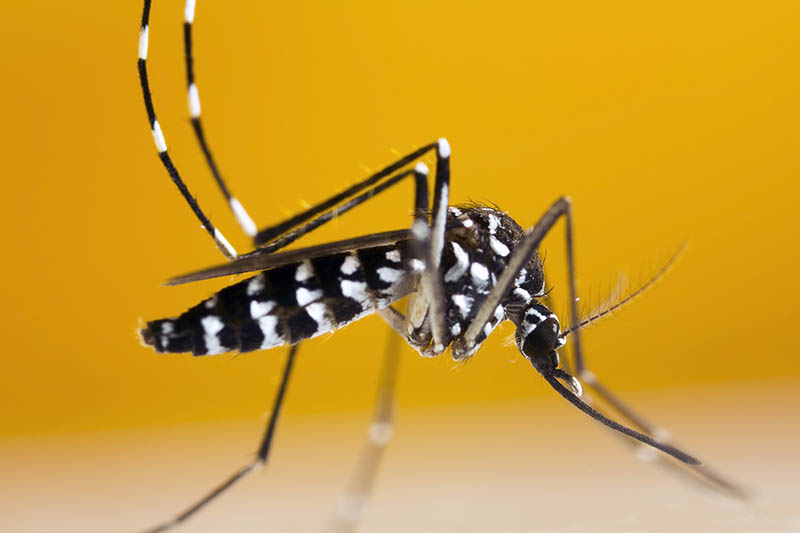6 Types of Mosquitoes in Texas (With Pictures)
-
Codee Chessher
- Last updated:

As the second-largest US state by land area, Texas has a huge variety of plants and wildlife across numerous types of climates. Unfortunately, that includes the dreaded mosquito. Mosquitoes are not only an annoying menace at barbecues and camping trips but may carry life-threatening diseases.
With over 85 identified species across the Lone Star State, six stand out among the rest. Let’s check them out below so you can stay better protected, whether you’re just visiting Texas or living there.
The 6 Types of Mosquitos in Texas
1. Asian Tiger Mosquito (Aedes albopictus)

| Favored habitat: | Stagnant water found anywhere |
| Disease vectors: | West Nile, Chikungunya, Zika, Dengue fever, yellow fever |
Topping our list is one of the most pernicious and tenacious mosquitoes in the US: the widely feared Asian Tiger mosquito. With a small, dark body, signature white striped back, and banded legs, the Asian Tiger mosquito will stay out all day and year long, as long as there’s stagnant water to be found.
They can lay eggs in any stagnant water body, even as small as a bottlecap! The worst thing about these mosquitoes is that they’re extremely aggressive at biting humans and pets alike.
2. Inland Floodwater Mosquito (Aedes vexans)

| Favored habitat: | Forests and marshes |
| Disease vectors: | Dog heartworm |
Ironically enough, our number two pick is the most common mosquito species in the US, and they’ve been found on every continent except Antarctica. Inland floodwater mosquitoes prefer to lay their eggs on temporary and permanent standing water, from rain-surging ditches to puddles. They aren’t a vector for any serious human diseases, but they do carry heartworm that can be fatal for dogs.
3. Southern House Mosquito (Culex quinquefasciatus)

| Favored habitat: | Polluted stagnant water |
| Disease vectors: | West Nile, St. Louis encephalitis, Zika |
This mosquito’s stealthy light-brown body belies its danger—the southern house mosquito is the top disease vector for the West Nile virus in the US! These pests prefer to bite birds, but have no qualms about feeding on humans either.
The good news is that they’re only active in the evening and nighttime, preferring to lay eggs in polluted standing water. Be warned that they’re also vectors for Zika and St. Louis encephalitis.
4. Dark Rice Mosquito (Aedes sollicitans)
| Favored habitat: | Temporary sources of stagnant water in grassy landscapes |
| Disease vectors: | Eastern Equine encephalitis, dog heartworm |
Less dangerous to humans than animals, the dark rice mosquito is also called the eastern saltmarsh mosquito. They have strikingly golden bodies dusted with silver spots and prefer to hang around farmlands and grasslands after rain.
As a vector for dog and equine diseases alike, dark rice mosquitoes are a serious problem for farmers and ranchers. These mosquitoes tend to strike during twilight hours.
5. Yellow Fever Mosquito (Aedes aegyptii)

| Favored habitat: | Containers with stagnant water |
| Disease vectors: | Yellow fever, Chikungunya, Dengue, Zika, Mayaro |
This mosquito is the primary vector for both yellow fever and Dengue fever, but it’s more than just a double threat—it’s also a vector for several other scary diseases. They’re such a successful disease vector because they prefer to use abandoned man-made containers with pooled stagnant water. Think flowerpots, used tires, and drainage ditches. The best way to prevent these is to minimize any stagnant water outside.
6. Common Malaria Mosquito (Anopheles quadrimaculatus)

| Favored habitat: | Clean, stagnant freshwater |
| Disease vectors: | Malaria, West Nile, and dog heartworm |
Many people think malaria is just a foreign thing, but these mosquitoes spread it just fine in the US on their own. These are larger and darker mosquitoes without banding or stripes, which makes them hard to see at night. They’re the main disease vectors for malaria in the US, but they’re also vectors for West Nile virus and dog heartworm.
Final Thoughts
From the hyper-aggressive Asian Tiger mosquito to the less-serious inland floodwater mosquito, there’s a huge range of mosquitoes across Texas that can cause itching and many worse things besides. Wearing a DEET bug spray is the best way to prevent mosquitoes from biting you in your Texas travels, so be sure to always have some on hand and keep you and your loved ones protected throughout the year.
Featured Image Credit: Vinicius R. Souza, Shutterstock
Contents
